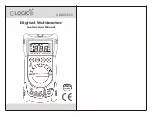
note:
1) In the small voltage range, such as DC 2V or AC 2V range, the pen is not connected
to the measured electrical
The LCD will have a beating reading, which is normal, this is because the instrument
caused by high sensitivity, when the instrument connected to the circuit under test,
you will get a real measurement.
2) "
" indicates that the maximum input voltage is 600V AC or 600V DC. 14
3) If the meter detects a reading greater than 600V DC or 600Vrms AC, a "beep" alarm
sounds.
4.8
AC and DC current measurement
Warning
Risk of electric shock
Do not attempt to perform current measurement on the circuit when the voltage between
the open circuit and ground exceeds 250V. If the fuse is blown during measurement, it
may damage the instrument or damage yourself.
In order to avoid damage to the instrument or equipment under test, before
the current measurement, please check the instrument fuse. When measuring,
use the correct input socket, function and range. Do not connect the other
end of the test leads in parallel to any circuit when the test leads are
inserted in the current input receptacle
The AC and DC current range of the instrument is 200uA, 2000uA, 20mA, 200mA, 10A.
Measure current
1) Turn the rotary switch to the appropriate gear. Select AC or DC current function as
needed.
2) Connect the black test lead to the COM input socket. If the measured current is less
than 200mA, connect the red test pen to the mA input socket. If the measured current
is between 200mA and 10A, connect the red test lead to the 10A input socket.
3) Disconnect the circuit to be tested. Connect the black test pen to one end of the
disconnected circuit (the lower voltage) and connect the red test lead to the other end









































